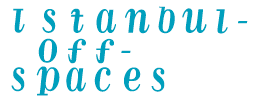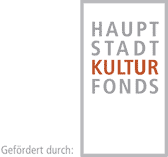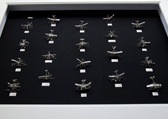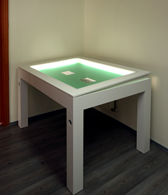 |
|||||||||||||||||||||||||||||||||||||||||||||||||||||||||||
|
|||||||||||||||||||||||||||||||||||||||||||||||||||||||||||
|
Masa Projesi www.masabout.blogspot.com Masa Project* uses a special table as exhibition space
and defines itself as: * Masa: Table About Masa Önder Özengi: Vahit, MASA (literally meaning table in Turkish) entered our art scene in the year 2006 with the exhibition of Erinç Seymen. Can we go a little further back? How did you come up with this idea and with whom did you cooperate in realizing it? Vahit Tuna: MASA’s priority was taking personal initiative. This project emerged at the conjunction of the “me-office-art production” triangle and the “sharing-new space- independence” triangle. Then it needed to become organic and integrated into a natural process. We can also interpret this project as an attempt to break down the homogenous definition of art and to bring art down from its place on an ivory tower. An action that lead to new cracks and to leakages from these new cracks and the formation of little lakes from these leakages… An act of creating new narratives and exhibition opportunities open to experimentation and allegory that aim at breaking down the existing and widely taught meta-narratives of art. A process of taking initiative to support a need for creating art for no reason. MASA was created as a wholly independent formation that would have problems with integrating into the system right to the very end. ÖÖ: Masa has realized 16 exhibitions so far. Let’s talk about unrealized projects and interesting proposals. I remember Şener Özmen’s rakı-drinking proposal. What other interesting project proposals did you receive aside from those that were realized? VT: All serious proposals were realized. All those works that aimed at participating in the Masa project with commitment were exhibited; but there were several projects that were intended just to make conversation… Of course, the initiative to realize an exhibition lies with the artist; we are only trying to help. For this reason, we sometimes encounter problems when it comes to opening up to public space. ÖÖ: I was included in MASA project in April 2008. What was the reason
for this invitation? Was it a bottleneck or an opportunity for opening
up? ÖÖ: Let’s talk about future projects. Masa book, Berlin Masa and another Masa planned in Spain. What do you think these mean? Aside from being the foreign replicas of an alternative exhibition space… VT: We tried to document every exhibition –with all the talks, all the texts written on the works, etc. This activity was aimed at producing a book in the end. I hope we can find the necessary resources to realize this book. It is exciting for us to see that Masa project is being replicated in other art centers. It stands proof to the fact that small scale actions can also have big impacts. Humble tolerance will expand its space by increasing its functionality at the face of gigantic institutionalism. VT: What’s missing in contemporary art today, Önder? ÖÖ: I think there is no criticism. This allows the energy around to express itself in an uncontrolled manner, which is good in terms of increasing the production. But on the other hand, it causes the content of production to dry out and the possible relations that ideas and concepts form or might form with other disciplines to be impoverished from the start. VT: How modern is it to take initiative on the local level? Masa, June 2009
Exhibited Project POLIS Isabel Schmiga* Isabel Schmiga is fascinated by the potential for an object or idea to change state, which she then examines and puts into process either literally or figuratively. In many of her works existing objects such as ties, leaves, marbles and forks, or printed images and diagrams are transformed into new, more conceptually complex versions of themselves. But in her work POLIS, her starting point is an extremely specific emblem - it is the Turkish Police badge, a designed composition of imagery that is already a socially and politically charged effigy. Schmiga's version of this badge in her work POLIS presents an extremely uncanny proposal. Through a layering of a carved relief of the emblem atop the original design, Schmiga draws attention to the badge's eerie skull-like shape: the outline of the skull is already marked out by the symmetrical, aerial view of a police cap that creates the shape of the badge; the double eagle insignia forms a moustache; the crescent moon and star motif an ominous third eye. As in Hans Holbein's The Ambassadors, 1533, the layered representation is rendered as if in anamorphic perspective and only becomes clear when viewed from an angle. As the cut outs appear and their depth gives a slight shadow, a perfect skull appears. In this camouflaged state, the badge, like the police it adorns, amalgamates an aura of protection with an implication of fear. Schmiga became obsessed by this authoritarian ornament after spending
several months living opposite a police guard in Istanbul, Turkey. This slippage is then pushed by Schmiga, so that other signs and symbols become more obviously integrated into her interpretation of this emblem. By placing the mouth of the skull in line with the double-eagle motif, she visually replicates a different statement of nationalism, the preference for males to don a moustache. The third-eye is formed by Turkey's flag, suggesting the overriding presence of National authority, but at the same time it is a reference to Islam and the rule of the former Ottoman empire; a combination of associations that can be read as the eye of knowledge, a control of will, or a system of belief, all issues that are very pertinent to the political situation in Turkey today. When exhibited POLIS consists of a repetitive series of Schmiga's photographic reliefs snugly butted up against one another filling the length of an entire wall. There are never less than five of the framed images presented at one time, a reference to the group presence of the police in Istanbul especially in the central entertainment zone of Istiklal Caddesi. Here police are nearly always present in groups of at least three, and often usually five or more. During public demonstrations or pre-publicised events when the police anticipate their necessity, they often outnumber those they are supposedly protecting, but are in fact waiting to control. In Basel for Schmiga's exhibition in von Bartha Garage, 60 of the badges were positioned in a slightly uneven line hinting at the meagre allowance of individuality given to each member of the formation, as well as the tension felt in numbers and in the expectancy of friction. The skull seen in such prevalence and force also replicates the gas masks often worn prematurely by the police before the potential, or actual release of tear gas, a practice that is not uncommon in the current climate of the city. Hence for a variety of reasons and on many levels Schmiga's work creates a sense of deja vu for those who live in the vicinity of this badge. As the skull was always there for Schmiga, it is now also always there for those who have experienced her work. Through a simple visual act she has marked a new relationship between the public and their encounter with this particular sign of the police. More importantly her work encourages a more general moment of reflection for us all on society's level of acceptance of forms of power and control in our every day environment. NOVEMBER PAYNTER |
|
|||||||||||||||||||||||||||||||||||||||||||||||||||||||||
|
|
|
||||||||||||||||||||||||||||||||||||||||||||||||||||||||||
 |
|
||||||||||||||||||||||||||||||||||||||||||||||||||||||||||
|
 |





